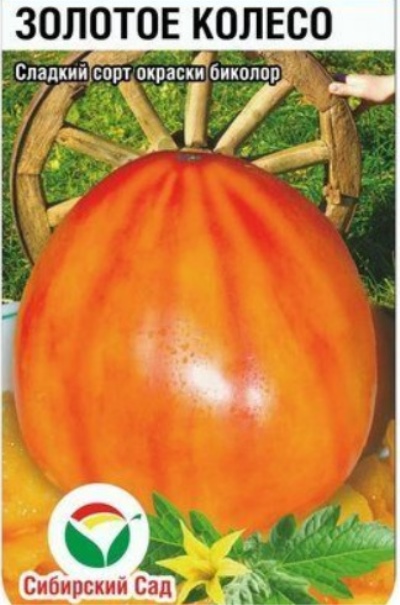
- Category: grade
- Growth type: indeterminate
- Appointment: fresh consumption
- Ripening period: mid-season
- Ripening time, days: 110-115
- Growing conditions: for open ground, for film greenhouses
- Bush height, cm: up to 180
- Bush characteristic: compact
- Foliage: medium
- Ripe fruit color: orange with fuzzy crimson red stripes
Comparatively small tomatoes are popular with a lot of people. However, this does not mean that you can ignore the characteristics of each particular plant. A striking example of a good tomato is the Golden Wheel - and you should definitely deal with it.
Description of the variety
The Golden Wheel belongs to the category of indeterminate cultures. It can be grown both in open ground and under plastic wrap - subject to agricultural standards, these tasks are solved very easily. The bushes can grow up to 1.8 m. The compact plants of the Golden Wheel are characterized by medium foliage.
The main qualities of the fruit
The ripe berries of this variety are orange. It is complemented by red-crimson stripes, but such stripes are not very clear. The mass of tomatoes varies from 0.2 to 0.35 kg. In shape, they resemble a stereotypical heart. The size of the fruit is large enough.
Taste characteristics
The berries of the Golden Wheel are sweet. They leave a good impression. Inside is juicy pulp. It is of medium density and contains few seeds. The pulp is colored yellow, diluted with pink stripes.
Ripening and fruiting
The Golden Wheel is a high-quality mid-season crop. On average, it takes from 110 to 115 days to ripen. A few more days must be added to discard green shoots.
Yield
Such a plant is distinguished by solid fertility. The number of fruits per 1 sq. m can reach 10 kg. However, such a result is possible only with strict adherence to agricultural techniques. Some sources write that the harvest reaches 6-7 kg.
The timing of planting seedlings and planting in the ground
Sowing seeds in seedling containers should be in mid-March. Doing it too early simply doesn't make sense. But postponing the procedure for a long time is hardly reasonable. The seedlings are ready for planting in a permanent place after 56-58 days. However, one must also take into account how well specific bushes are developing, whether they have time to get stronger.

Growing tomato seedlings is an extremely important process, because it largely depends on whether the gardener can harvest at all. All aspects must be taken into account, from seedbed preparation to planting in the ground.
Landing scheme
In greenhouses, 4 plants are planted per 1 m2. In the open field, 3 or 4 bushes can be planted in the same area. The more difficult the growing conditions, the more relevant it is to reduce this number. Then the plants will not interfere with each other, and it will become easier to take care of them.

Growing and caring
Formation is usually carried out in 2 barrels. It is advisable to remove stepchildren every 7-10 days. For seedlings, a nutritious substrate is needed in the form of a loose mass. It is necessary to close the seeds to a depth of 2 cm. Top dressing is applied 2 times, it is best to use the preparation "Kemira".
A pick is traditionally carried out when 1-2 true leaves appear. Seedlings should be hardened at the age of 7-10 days. Seedling training (hardening) is carried out on warm sunny days. For this purpose, simply raise the film a little. Seedlings should be treated with herbicides a day before transplanting into open ground. It is unacceptable to exceed the concentration of drugs prescribed in the instructions.
The garter is performed on trellises. Be sure to use columns. The response to watering and fertilization is very good. Otherwise, there are no differences from the cultivation of other varieties of tomatoes.
When active growth stops and the beginning of fruit formation, fungicides are used. 1 or 2 treatments with them allow you to guarantee protection against late blight. Passynching should be performed at the beginning of active growth. Irrigation should be minimal in the first 2-3 weeks after planting to maximize root penetration and increase plant viability. At this moment, the soil is loosened only superficially, excluding the emergence of weeds.
When cultivated in open ground, it is supposed to remove all lateral suckers at the end of July or at the beginning of August. This will allow the plant to concentrate maximum energy on the development of the main stem. It is enough to pinch the top of the bush. The exact moment when it is necessary to stop development depends on the climatic zone and the actual weather. Having completed these not so difficult work, any gardener can count on a decent result.




A plant needs different micronutrients at each stage of growth. All fertilizers can be divided into two groups: mineral and organic. Folk remedies are often used: iodine, yeast, bird droppings, eggshells.
It is important to observe the rate and period of feeding. This also applies to folk remedies and organic fertilizers.



























































































